The Rider’s Mindset: Unlocking Your Potential in the Saddle
Horseback riding is thought of as a physically demanding sport, requiring strength, balance, and coordination. Seasoned riders know that the true mastery of this equestrian sport extends far beyond physical ability. The mental game of horseback riding is equally, if not more, important in developing a harmonious relationship with your horse and achieving peak performance.
I know that the bond between my horse and me is a unique and delicate balance of trust, communication, and mutual understanding. I also realize that my mental state greatly influences my horse’s behavior and responsiveness. Whether you’re a beginner embarking on your exciting horseback riding journey or an experienced rider seeking to refine your skills, cultivating a strong mental game is crucial. It’s essential for truly enjoying a fulfilling and lifelong passion with horses.
In this post, we will look into the many aspects of the mental game of horseback riding. From building confidence and focus to managing fear and anxiety, we will look into strategies to build mental resilience. Understanding and harnessing the power of your mind can lead to more enjoyable and successful rides, both in practice and in competition.
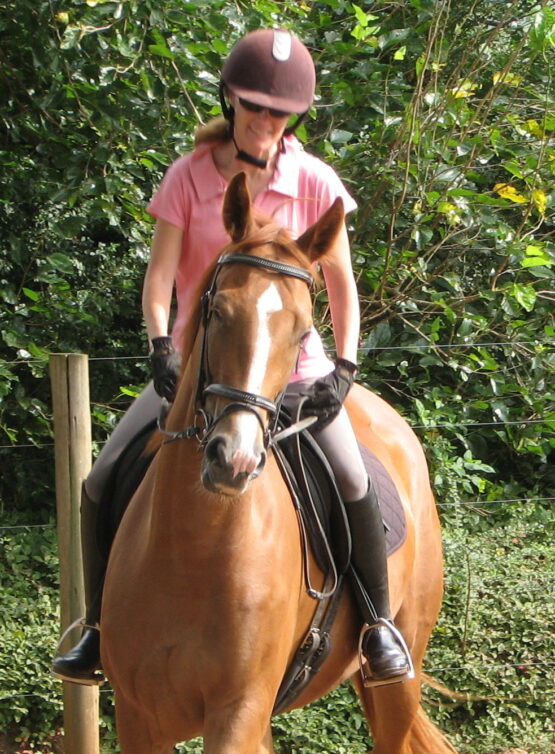
Understanding the Mental Game
The mental game of horseback riding encompasses the psychological aspects that influence your performance and relationship with your horse. It’s not just about being physically fit or technically proficient; it’s about having the right mindset, emotional control, and mental resilience to navigate the complexities of riding.
The Mind-Horse Connection
The bond between you and your horse is built on trust and communication. Horses are extremely intuitive animals that can sense your emotions and react accordingly. If you are anxious or distracted, your horse can become uneasy and uncooperative. On the other hand, a calm and confident rider can help create a sense of security and trust in your horse, leading to a more harmonious and responsive relationship.
How it Influences Performance
Your mental state has a direct impact on your riding performance. When you are mentally prepared and focused, you can better anticipate and react to your horse’s movements, maintain proper form, and execute riding techniques more effectively. A positive mindset helps you stay motivated, overcome challenges, and enjoy the riding experience more fully.
Components of the Mental side of riding
Several key components contribute to a strong mental game in horseback riding:
- Confidence: Believing in your abilities and maintaining self-assurance even in challenging situations.
- Focus: The ability to concentrate on the task at hand, blocking out distractions and staying present in the moment.
- Emotional Control: Managing emotions such as fear, frustration, and excitement to maintain a calm and composed demeanor.
- Resilience: The capacity to recover from setbacks and persist through difficulties.
- Mental Preparation: Using visualization and other techniques to mentally rehearse and prepare for rides and competitions.
By understanding these components and actively working on them, you can enhance your mental game and, in turn, improve your overall riding performance.
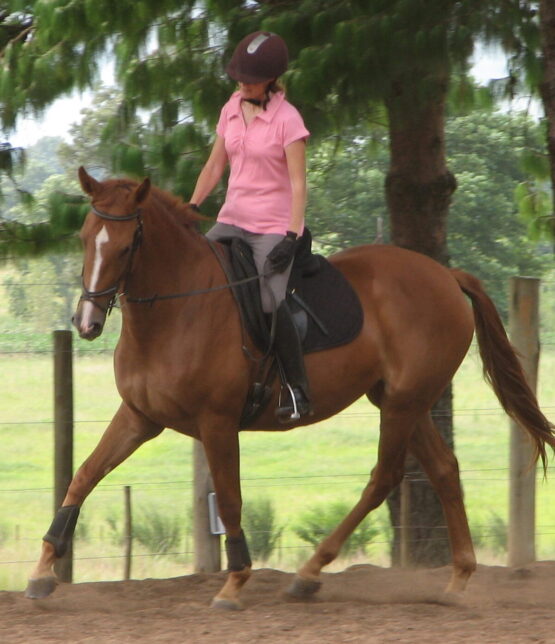
Building Confidence
Confidence is the foundation of successful horseback riding. A confident rider communicates assurance and calmness to their horse, which helps create a trusting and responsive relationship. Here are some techniques to build and maintain self-confidence in horseback riding:
Visualization Exercises
Visualization is a powerful tool that can help boost confidence by mentally rehearsing successful rides. Here’s how to practice effective visualization:
- Find a Quiet Space: Sit in a quiet place where you won’t be disturbed.
- Close Your Eyes: Imagine yourself riding confidently and smoothly. Visualize every detail, from mounting your horse to executing specific movements.
- Engage All Senses: Picture the sights, sounds, and sensations of riding. Imagine the feel of the reins in your hands, the rhythm of your horse’s gait, and the wind on your face.
- Focus on Success: Visualize overcoming challenges and achieving your goals. This mental rehearsal can help build your confidence by creating a positive and familiar mental image of success.
Setting Achievable Goals
Setting realistic and attainable goals can help boost your confidence by providing a clear path for progress and accomplishment. Follow these steps to set effective goals:
- Start Small: Begin with simple, achievable goals that match your current skill level. This could be mastering a particular riding technique or successfully completing a short trail ride.
- Be Specific: Clearly define what you want to achieve. Instead of a vague goal like “be a better rider,” set specific objectives like “improve my posting trot” or “develop a smoother canter transition.”
- Track Progress: Keep a journal to document your progress. Celebrate small victories and note improvements over time. This can help reinforce your confidence as you see tangible evidence of your growth.
Positive Self-Talk and Affirmations
The way you talk to yourself has a significant impact on your confidence. Positive self-talk and affirmations can help build a resilient and optimistic mindset:
- Identify Negative Thoughts: Pay attention to negative thoughts or self-doubt that arise while riding. Challenge these thoughts by questioning their validity and considering more positive alternatives.
- Use Positive Affirmations: Create a list of affirmations that resonate with you, such as “I am a capable and confident rider” or “I can handle any challenge that comes my way.” Repeat these affirmations regularly, especially before and during rides.
- Focus on Strengths: Remind yourself of your strengths and past successes. Reflecting on what you’ve already achieved can boost your confidence and reinforce your belief in your abilities.
By incorporating these techniques into your riding routine, you can build and maintain a strong sense of confidence. Confidence not only enhances your riding performance but also contributes to a more enjoyable and fulfilling experience with your horse.

Developing Focus and Concentration
Focus and concentration are crucial for effective horseback riding. A rider who can stay present and attentive is better equipped to respond to their horse’s movements and maintain control. Here are some strategies to help you develop and enhance your focus and concentration while riding:
The Importance of Staying Present
Staying present means fully engaging in the current moment and task at hand. In horseback riding, this involves being aware of your surroundings, your horse’s behavior, and your actions. Staying present helps you:
- Respond Quickly: Being aware allows you to respond swiftly to your horse’s signals and movements.
- Maintain Safety: Staying focused helps prevent accidents by ensuring you notice potential hazards.
- Improve Performance: Concentration allows for precise execution of riding techniques and better overall performance.
Mindfulness and Meditation
Mindfulness and meditation can help enhance your ability to stay present and focused. These practices train your mind to concentrate on the current moment, reducing distractions and improving mental clarity:
- Mindfulness Practice: Before riding, spend a few minutes practicing mindfulness. Sit quietly and focus on your breath, noticing each inhale and exhale. If your mind wanders, gently bring your attention back to your breath. This practice can help center your mind and prepare you for a focused ride.
- Meditation: Incorporate regular meditation into your routine. Even just 10-15 minutes a day can improve your ability to concentrate. Use guided meditations that focus on relaxation and mental clarity.
Breathing Techniques
Proper breathing techniques can help you stay calm and focused while riding. Deep, controlled breathing helps reduce anxiety and improves oxygen flow to your brain, enhancing concentration:
- Deep Breathing: Practice deep breathing exercises before and during your ride. Inhale deeply through your nose, hold for a few seconds, and exhale slowly through your mouth. Repeat this several times to calm your mind and body.
- Box Breathing: This technique involves inhaling for a count of four, holding your breath for a count of four, exhaling for a count of four, and holding again for a count of four. This rhythmic breathing can help you stay centered and focused.
Pre-Ride Routines
Establishing a pre-ride routine can help you mentally prepare and enter a focused state before getting on your horse:
- Consistent Routine: Develop a consistent pre-ride routine that includes activities like grooming your horse, checking your tack, and doing a quick warm-up. This routine signals to your brain that it’s time to focus.
- Mental Checklist: Create a mental checklist of key points to remember while riding. This could include maintaining proper posture, being aware of your horse’s cues, and staying relaxed. Review this checklist before mounting your horse.
Techniques to Maintain Focus During Rides
Staying focused during your ride requires practice and conscious effort. Here are some tips to help you maintain concentration:
- Break Tasks into Smaller Steps: Focus on one aspect of your riding at a time. For example, concentrate on your seat position, then move on to rein control. Breaking tasks into smaller steps makes them more manageable and keeps your mind engaged.
- Use Visual Markers: Identify specific visual markers in your riding environment, such as trees, poles, or cones. Use these markers to help you stay oriented and focused on your path.
- Practice Riding Patterns: Riding specific patterns or exercises can help keep your mind engaged. This might include practicing circles, figure eights, or transitions between gaits.
Using some of these strategies in your riding routines will help you develop stronger focus and concentration, enhancing your overall performance and safety.
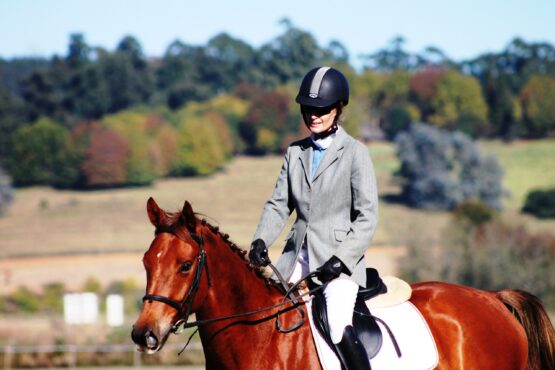
Managing Fear and Anxiety
Fear and anxiety are common emotions in horseback riding, affecting riders of all levels. These feelings can stem from past falls, challenging riding experiences, or simply the normal nerves of riding a young horse at a show for the first time. Managing fear and anxiety is crucial for maintaining control and building a positive riding experience. Here are some strategies to help you cope:
Common Fears Riders Face
Understanding the sources of fear can help you address them more effectively. Common fears among riders include:
- Fear of Falling: Worrying about potential falls or accidents.
- Fear of Losing Control: Concerns about not being able to manage the horse’s behavior.
- Fear of Failure: Anxiety about not performing well or meeting expectations.
- Fear of the Unknown: Uncertainty about new riding environments, horses, or situations.
Strategies to Cope with Fear
To manage fear and anxiety, it’s essential to use a combination of mental and practical strategies. Here are some effective techniques:
Gradual Exposure to Challenging Situations
- Start Small: Begin with tasks and situations that are within your comfort zone and gradually increase the difficulty as you build confidence.
- Controlled Environment: Practice in a safe, controlled environment where you feel secure. Gradually introduce new challenges as you become more comfortable.
Cognitive-Behavioral Techniques
- Identify and Challenge Negative Thoughts: Recognize negative or irrational thoughts that contribute to your fear. Challenge these thoughts by examining the evidence and considering more positive, realistic perspectives.
- Reframe Your Mindset: Shift your focus from potential failures to opportunities for growth and learning. Instead of thinking, “I might fall,” consider, “This is a chance to improve my balance and control.”
Support from Trainers and Peers
- Seek Guidance: Work with a knowledgeable trainer who can provide guidance, support, and reassurance. A trainer can help you develop a personalized plan to address your fears.
- Peer Support: Connect with other riders who may have similar experiences. Sharing your fears and successes with peers can provide encouragement and a sense of camaraderie.
Practical Exercises to Reduce Anxiety
Incorporating specific exercises into your routine can help reduce anxiety and build confidence:
Groundwork and Desensitization
- Groundwork: Spend time working with your horse on the ground to build trust and familiarity. Groundwork exercises help you and your horse develop a strong bond and improve communication.
- Desensitization: Gradually expose your horse to various stimuli, such as loud noises or unfamiliar objects, in a controlled manner. This can help reduce your horse’s reactivity and, in turn, decrease your anxiety.
Progressive Muscle Relaxation
- Relaxation Techniques: Practice progressive muscle relaxation to reduce physical tension. This involves tensing and then relaxing different muscle groups in your body, helping to release stress and promote calmness.
Breathing and Visualization
- Breathing Exercises: Use deep breathing techniques to calm your mind and body before and during your ride. Focus on slow, deep breaths to reduce anxiety.
- Visualization: Visualize successful rides and positive outcomes. Picture yourself riding confidently and calmly, handling challenges with ease.
Building Resilience
Building resilience is key to managing fear and anxiety in the long term. Resilience helps you bounce back from setbacks and maintain a positive outlook:
Learning from Setbacks
- Reflect on Experiences: After each ride, take time to reflect on what went well and what could be improved. Use setbacks as learning opportunities to develop your skills and build resilience.
Celebrate Progress
- Acknowledge Achievements: Celebrate your progress, no matter how small. Recognizing your achievements can boost your confidence and reinforce a positive mindset.
When riding horses, fear isn’t at the forefront of our minds—it can’t be, or it would ruin every ride. As responsible, thoughtful humans, we logically understand that riding is inherently risky. We’re placing our trust in a large, powerful animal, which does involve some danger. However, by thoughtfully working through our natural fears with mindfulness, we can manage any anxiety and fully enjoy our riding experience.

Enhancing Communication with Your Horse
Effective communication between you and your horse is fundamental to successful horseback riding. A clear, consistent, and respectful exchange of signals fosters a trusting and responsive partnership. Here are some techniques to improve your communication with your horse:
The Role of Mental Clarity in Communication
Mental clarity is essential for effective communication with your horse. A focused and calm mind allows you to convey clear signals, making it easier for your horse to understand and respond appropriately. When you are mentally present and aware, you can:
- Read Your Horse’s Signals: Recognize and interpret your horse’s body language and responses.
- Adjust Your Cues: Modify your cues based on your horse’s reactions to ensure clear and effective communication.
- Maintain Consistency: Consistent cues and commands help your horse understand your expectations and build trust.
Techniques to Improve Horse-Rider Communication
Improving communication with your horse involves developing awareness of your body language, using consistent cues, and fostering a mutual understanding. Here are some practical techniques:
Body Language Awareness
- Posture and Position: Maintain a balanced and relaxed posture while riding. Your body position should be aligned with your horse’s movement, signaling harmony and control.
- Subtle Cues: Use subtle shifts in weight and leg pressure to communicate with your horse. Overly forceful or unclear signals can confuse your horse and disrupt the flow of communication.
- Eye Contact: Establish eye contact with your horse during groundwork to build a connection and convey your intentions.
Consistent Cues and Commands
- Clear Signals: Use clear and distinct cues for different commands, such as starting, stopping, turning, and changing gaits. Consistency helps your horse associate specific cues with desired actions.
- Verbal Commands: Incorporate verbal commands in combination with physical cues. Use a calm and consistent tone of voice to reinforce your signals.
- Reinforcement: Reinforce positive behavior with rewards, such as gentle pats, treats, or verbal praise. Positive reinforcement encourages your horse to respond favorably to your cues.
Building Trust and Mutual Understanding
Trust is the foundation of effective horse-rider communication. Developing a trusting relationship with your horse involves patience, respect, and mutual understanding:
Spending Quality Time
- Bonding Activities: Spend quality time with your horse outside of riding. Activities such as grooming, hand-walking, and simply being present with your horse help build trust and familiarity.
- Groundwork: Engage in groundwork exercises that focus on building trust and communication. Groundwork helps establish your role as a calm and confident leader.
Consistency and Patience
- Consistent Routine: Establish a consistent routine for training and riding sessions. Horses thrive on routine and predictability, which helps reduce anxiety and build trust.
- Patience: Be patient with your horse, especially when introducing new tasks or challenges. Allow your horse time to understand and respond to your cues without rushing or forcing.
Enhancing Communication During Rides
During rides, effective communication requires continuous attention and adaptability. Here are some tips to enhance communication while riding:
Paying Attention to Feedback
- Listen to Your Horse: Pay attention to your horse’s reactions and adjust your cues accordingly. If your horse seems confused or resistant, reassess your signals and make adjustments.
- Adaptability: Be flexible and willing to modify your approach based on your horse’s responses. Each horse is unique, and what works for one may not work for another.
Practice and Repetition
- Consistent Practice: Regularly practice communication exercises to reinforce your cues and build a strong connection with your horse.
- Repetition: Use repetition to reinforce learning and build muscle memory for both you and your horse. Consistent practice helps solidify the communication pathways.
Nothing is more rewarding and exhilarating than when the communication with your horse becomes so clear that he responds to your very thoughts. Even before you physically ask for something, he understands exactly what you’re thinking and moves accordingly. This happens because as you think, your body subtly changes, and your horse, being so in tune with you, feels these tiny movements and reacts instantly. I’ve experienced this incredible bond with many horses over the years. It takes a lot of time and dedication, but it’s one of the many reasons we love these animals so much—our connection becomes incredibly strong.

Dealing with Setbacks
Setbacks are a natural part of horseback riding, as they are in any sport or skill. Learning to handle them effectively is crucial for continuous improvement and maintaining a positive mindset. Here are some strategies to help you deal with setbacks and keep your motivation high:
Accepting Mistakes as Part of the Learning Process
Mistakes and setbacks are inevitable, but they are also valuable learning opportunities. Embracing this perspective can help you stay resilient and focused on growth:
- Normalize Mistakes: Understand that every rider, regardless of experience level, encounters setbacks. Accepting this can reduce frustration and anxiety.
- Growth Mindset: Cultivate a growth mindset by viewing mistakes as opportunities to learn and improve. Reflect on what went wrong and how you can do better next time.
Techniques to Maintain Motivation
Staying motivated through setbacks requires a proactive approach. Here are some techniques to help you stay committed to your riding goals:
Reflecting on Progress
- Progress Journal: Keep a journal to track your progress, noting both successes and areas for improvement. Reflecting on your journey can provide a sense of accomplishment and highlight your growth.
- Celebrate Small Wins: Acknowledge and celebrate even the smallest achievements. Recognizing incremental progress can boost your confidence and motivation.
Learning from Setbacks
- Analyze and Adjust: After experiencing a setback, take time to analyze what happened. Identify any patterns or recurring issues and develop a plan to address them.
- Seek Feedback: Don’t hesitate to ask for feedback from trainers, peers, or mentors. Constructive feedback can offer new perspectives and help you overcome challenges more effectively.
Strategies to Stay Positive and Focused
Maintaining a positive and focused mindset is essential for dealing with setbacks and continuing to progress:
Positive Self-Talk
- Reframe Negative Thoughts: Replace negative self-talk with positive affirmations. For example, instead of thinking, “I’ll never get this right,” tell yourself, “I’m improving with each ride.”
- Encourage Yourself: Use encouraging language to boost your morale. Remind yourself of your strengths and past successes.
Mindfulness and Relaxation
- Mindfulness Practices: Engage in mindfulness exercises to stay present and reduce stress. Techniques like deep breathing, meditation, and visualization can help you stay calm and focused.
- Relaxation Techniques: Incorporate relaxation techniques into your routine to manage stress and maintain a positive mindset. Progressive muscle relaxation and yoga can be particularly beneficial.
Building a Support System
Having a strong support system can make a significant difference in how you handle setbacks and maintain motivation:
Mentors and Coaches
- Seek Guidance: Work with experienced mentors or coaches who can provide guidance, support, and constructive feedback. Their expertise can help you navigate challenges more effectively.
- Regular Check-Ins: Schedule regular check-ins with your mentor or coach to discuss your progress, address concerns, and receive encouragement.
Riding Groups and Communities
- Join a Riding Group: Connect with other riders through local clubs, groups, or online communities. Sharing experiences and advice with fellow riders can provide a sense of camaraderie and support.
- Peer Support: Develop relationships with riding peers who understand the challenges you face. Having someone to share both successes and setbacks with can be incredibly motivating.
A favorite mare, Rhapsody, did not like walking and halting during our schooling sessions—she was always eager to trot and was happiest moving forward, not coming back to me. As a dressage rider, I understand the critical importance of precise transitions. When I’d practice my dressage tests with her, asking for a walk transition at a specific letter she would stubbornly continue to trot. It became a constant challenge that would frustrate both of us in our schooling sessions.
I’d apply all the usual aids that always worked with other horses – but with Rhapsody, it would most often result in slower and tenser trotting, and when she finally did walk, it lacked the relaxation and fluidity I was looking for. These sessions left me feeling disheartened, especially with looming deadlines and tests to prepare for.
Taking a deep breath, both literally and figuratively, and sharing my frustrations with my support team—my trainer, husband, children, and anyone willing to listen—proved invaluable. After a tough session I would take Rhapsody the next day and come back to the training after a short break. Gradually, with consistent effort and patience, our walks improved bit by bit during each practice session. Consistency was key in mastering this seemingly simple yet crucial movement with my beloved mare.
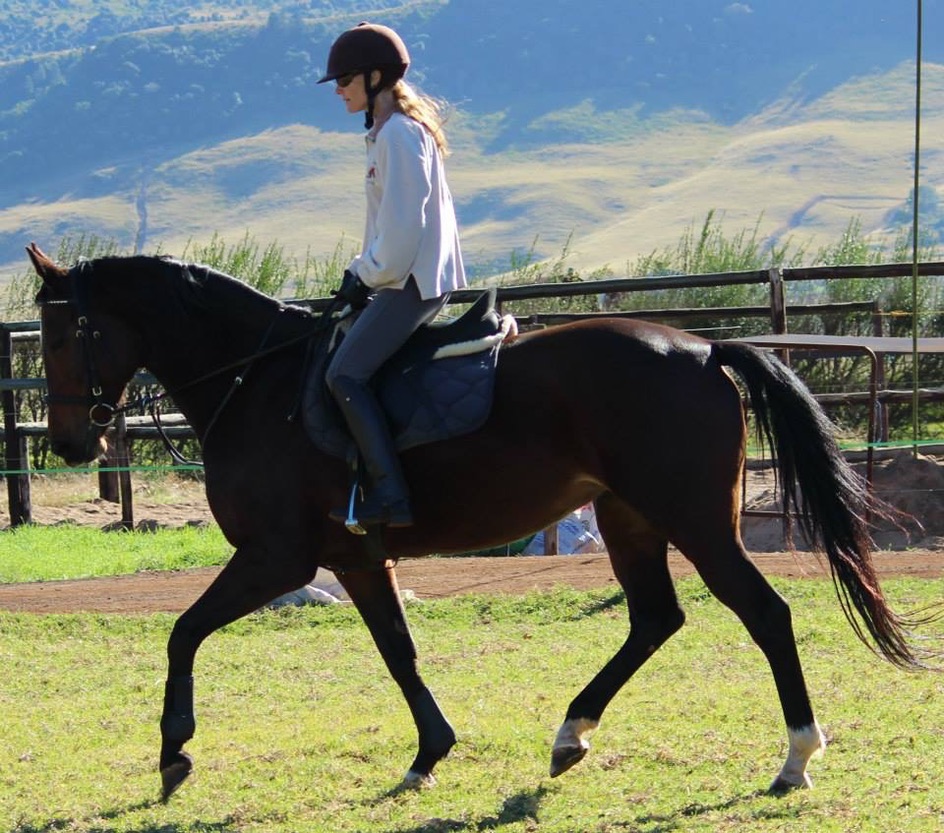
Mental Preparation for Competitions
Competing in horseback riding requires not only physical skill but also mental fortitude. Preparing mentally for competitions can help you stay calm, focused, and confident, enabling you to perform at your best. Here are some strategies for effective mental preparation:
Preparing Mentally for Shows and Competitions
Effective mental preparation begins long before the competition day. Developing a routine and mindset that promotes confidence and focus is key:
Consistent Training Routine
- Regular Practice: Ensure consistent training sessions leading up to the competition. Familiarity with your routines and techniques builds confidence.
- Simulation Exercises: Practice under conditions that simulate the competition environment. This can help you and your horse get used to the pressures and distractions of a show.
Goal Setting
- Set Clear Goals: Establish specific, realistic goals for the competition. Focus on personal improvement rather than solely on winning.
- Short-Term and Long-Term Goals: Have both short-term objectives for each competition and long-term goals for your overall riding journey.
Visualization Techniques
- Mental Rehearsal: Regularly visualize yourself successfully completing your competition routine. Imagine every detail, from the moment you enter the arena to the final movement.
- Positive Outcomes: Focus on positive outcomes and scenarios. Visualization helps build confidence and reduces anxiety by familiarizing your mind with success.
Strategies for Maintaining Calm and Focused Under Pressure
Staying calm and focused during the competition is crucial for optimal performance. Here are some techniques to help manage stress and maintain concentration:
Pre-Competition Routines
- Develop a Routine: Create a pre-competition routine that includes activities like grooming your horse, checking equipment, and warming up. This routine signals to your mind and body that it’s time to focus.
- Relaxation Exercises: Incorporate relaxation exercises such as deep breathing or progressive muscle relaxation to reduce anxiety.
Breathing Techniques
- Deep Breathing: Practice deep breathing exercises to calm your nerves. Inhale deeply through your nose, hold for a few seconds, and exhale slowly through your mouth. Repeat as needed to stay relaxed.
- Box Breathing: Use the box breathing technique—inhale for a count of four, hold for four, exhale for four, and hold for four. This rhythmic breathing can help maintain a steady, calm state.
Positive Self-Talk
- Affirmations: Use positive affirmations to reinforce your confidence. Statements like “I am prepared and capable” or “I trust in my training and my horse” can boost your mental state.
- Focus on Strengths: Remind yourself of your strengths and past successes. Concentrating on what you do well can help shift your focus from anxiety to confidence.
Mental Rehearsals
Mental rehearsals involve practicing your performance in your mind. This technique can help prepare you for different scenarios and improve your reaction to challenges:
Visualize Different Scenarios
- Best Case Scenario: Imagine your ideal performance, where everything goes perfectly. Visualizing success can help instill confidence and create a positive mindset.
- Challenge Scenarios: Visualize how you will handle potential challenges, such as your horse spooking or making a mistake. Planning your responses can help you stay composed under pressure.
Routine Reinforcement
- Consistent Practice: Regularly practice mental rehearsals as part of your training routine. Consistency helps reinforce neural pathways associated with successful performance.
- Focus on Details: Pay attention to every detail during mental rehearsals, from your posture and cues to your horse’s movements. This comprehensive visualization helps create a realistic and effective mental practice.
Dealing with Competition Nerves
Nerves are a natural part of competing, but they can be managed effectively with the right strategies:
Normalize Nervousness
- Acceptance: Accept that feeling nervous is normal and a sign that you care about your performance. Normalizing nerves can reduce their impact.
- Channel Energy: Use nervous energy to your advantage. Transform it into focused energy that can enhance your performance.
Grounding Techniques
- Stay Present: Use grounding techniques to stay present in the moment. Focus on sensory details like the feel of the reins, the sound of your horse’s breathing, or the rhythm of their gait.
- Mindfulness: Practice mindfulness to keep your mind from wandering to negative thoughts. Staying present helps maintain focus and reduces anxiety.
I never quite shook off the nerves when it came to show days—I don’t think any rider does. The jittery feeling of preparing for a class always lingered. Oddly enough, I found that I rode better because of it. Conquering those nerves became part of the thrill of competing.
Before each show, I’d inevitably experience a dry mouth, loss of appetite, a racing heart, and those infamous butterflies in my stomach. But the moment I mounted my horse and began our warm-up, the focus required for that task washed away my worries. I learned to set my nerves aside and concentrate fully on the job at hand.
Over time, I discovered what helped me best to calm my nerves. Acknowledging those feelings and finding ways to manage them became essential. Every rider eventually finds their own methods to ease show day jitters—it’s all part of the journey.
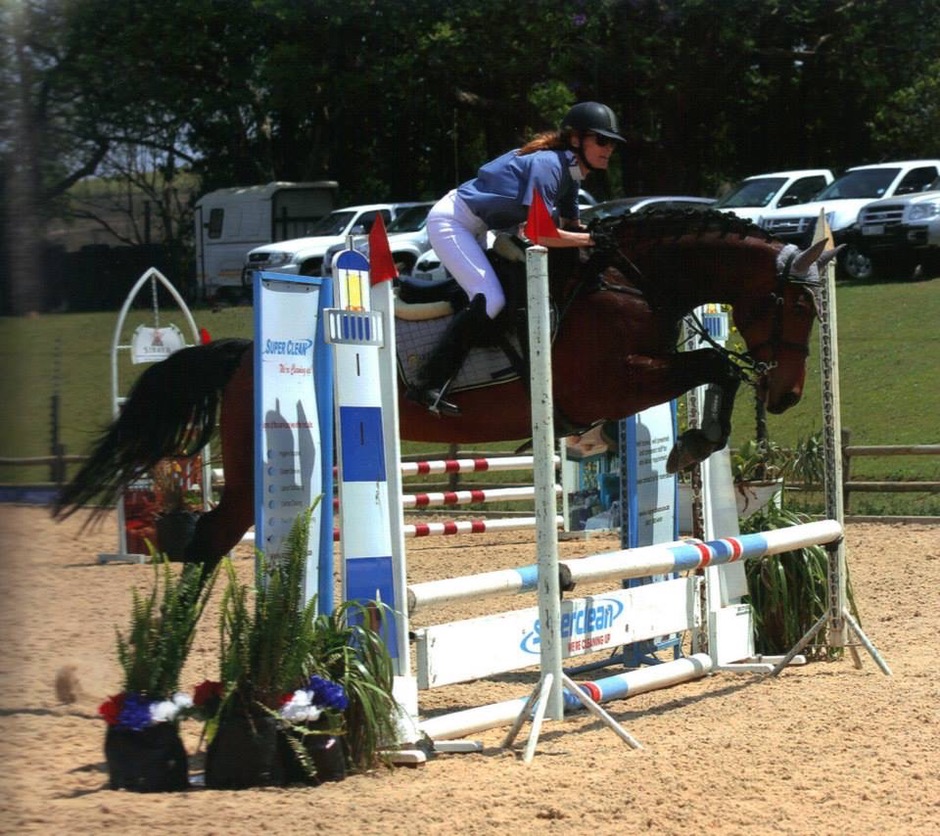
Building a Support System
A strong support system is vital for success in horseback riding, providing emotional encouragement, practical advice, and a sense of community. Here’s how to build and maintain an effective support system within the riding community:
The Importance of a Support Network
Having a reliable support network can make a significant difference in your riding journey. Benefits include:
- Emotional Support: Friends, family, and fellow riders can offer encouragement and reassurance, helping you stay motivated and positive.
- Practical Advice: Experienced riders and trainers can provide valuable insights and guidance to help you improve your skills and overcome challenges.
- Shared Experience: Connecting with others who share your passion for riding fosters a sense of belonging and camaraderie.
Finding and Connecting with Mentors
Mentors play a crucial role in your development as a rider. Here are some tips for finding and connecting with mentors:
Identify Potential Mentors
- Experienced Riders: Look for riders with extensive experience and a teaching mindset. They can offer practical advice and share their knowledge.
- Trainers and Instructors: Professional trainers and instructors can provide structured guidance and personalized training plans.
Building Relationships
- Reach Out: Don’t hesitate to approach potential mentors. Express your interest in learning from them and be open about your goals and challenges.
- Show Commitment: Demonstrate your dedication and willingness to learn. Consistent effort and a positive attitude can help build a strong mentor-mentee relationship.
Joining Riding Groups and Communities
Being part of a riding group or community offers numerous benefits, including shared knowledge, social connections, and mutual support:
Local Riding Clubs
- Join Clubs: Look for local riding clubs or organizations. These groups often organize events, training sessions, and social gatherings, providing opportunities to connect with other riders.
- Participate in Activities: Engage in club activities and events to build relationships and learn from fellow members.
Online Communities
- Join Forums and Groups: Participate in online forums and social media groups dedicated to horseback riding. These platforms offer a wealth of information and a supportive community.
- Share and Learn: Share your experiences and challenges, and learn from others’ insights and advice. Online communities can provide diverse perspectives and solutions.
Offering Support to Others
Being part of a support system means giving as well as receiving support. Here’s how you can contribute to the riding community:
Sharing Knowledge and Experience
- Mentor Novice Riders: Offer guidance to less experienced riders. Sharing your knowledge and experiences can help them grow and build confidence.
- Participate in Workshops: Volunteer to lead or assist in workshops and training sessions. Teaching others can reinforce your own skills and foster a sense of community.
Emotional Support and Encouragement
- Be Supportive: Offer words of encouragement and empathy to fellow riders facing challenges. Sometimes, a kind word can make a significant difference.
- Celebrate Successes: Celebrate the achievements of your peers. Recognizing and applauding their successes fosters a positive and supportive environment.
Building a Positive Riding Environment
Creating and maintaining a positive riding environment benefits everyone involved:
Promote Respect and Inclusivity
- Respect Differences: Respect the diverse backgrounds, skills, and goals of other riders. An inclusive environment encourages everyone to thrive.
- Encourage Open Communication: Foster open and respectful communication within your riding community. Constructive feedback and open dialogue contribute to a positive atmosphere.
Organize Social and Educational Events
- Host Events: Organize social gatherings, workshops, and training sessions to bring riders together. These events can strengthen bonds and provide valuable learning opportunities.
- Encourage Participation: Encourage fellow riders to participate in events and activities. Active involvement enhances the sense of community and mutual support.
By building and nurturing a strong support system, you can enhance your riding experience and contribute to the growth and well-being of the entire riding community. This collective support not only helps individual riders thrive but also fosters a positive and encouraging environment for everyone involved.
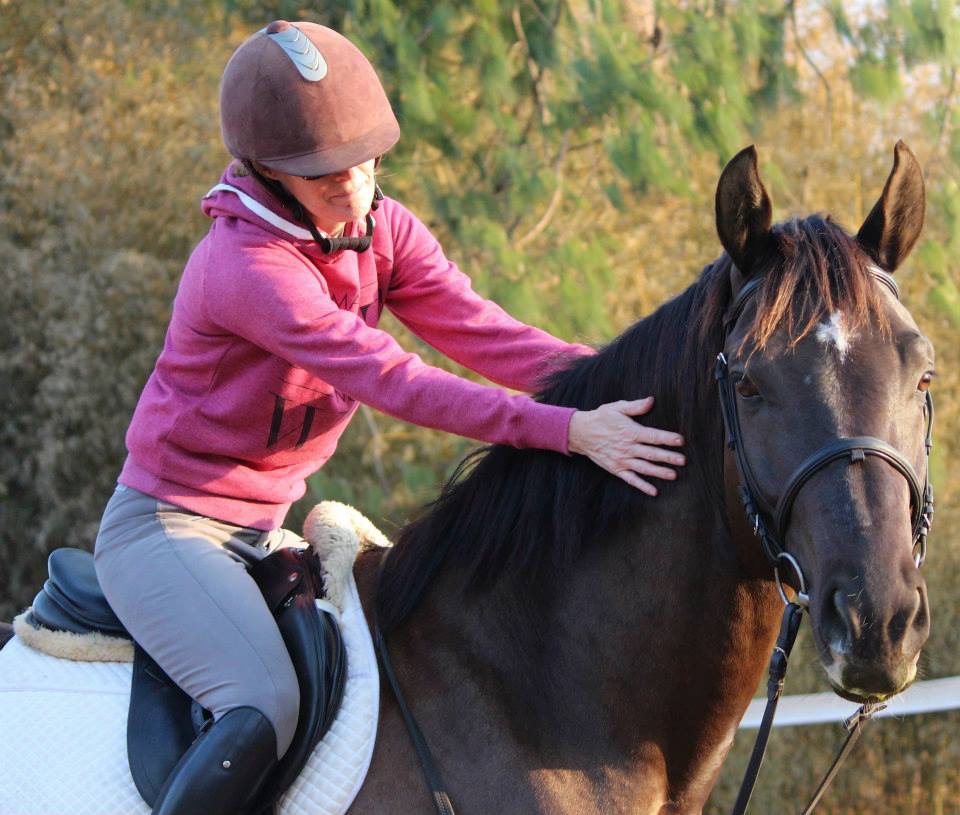
Conclusion
Mastering the mental game of horseback riding is a journey that requires dedication, resilience, and a deep understanding of both yourself and your equine partner. Throughout this article, we’ve explored essential strategies to enhance your mental skills, ultimately leading to improved performance and enjoyment in riding.
From building confidence and developing focus to managing fear, enhancing communication with your horse, and preparing mentally for competitions, each section has provided valuable insights and practical techniques. By incorporating these strategies into your training routine, you can cultivate a strong mental foundation that supports your riding goals.
Remember, progress in horseback riding, like any sport, involves both successes and setbacks. Embrace challenges as opportunities for growth, and maintain a positive mindset. Building a supportive network of mentors, peers, and riding communities can provide invaluable encouragement and guidance along your journey.
Whether you’re a novice rider aspiring to improve your skills or an experienced competitor striving for peak performance, your mental approach plays a pivotal role in your success. Stay committed to continuous learning, practice with intention, and enjoy the profound bond that develops between you and your horse through the art of riding.
With determination, perseverance, and a well-nurtured mental game, you can achieve your riding goals and experience the full richness of the equestrian journey. Happy riding!
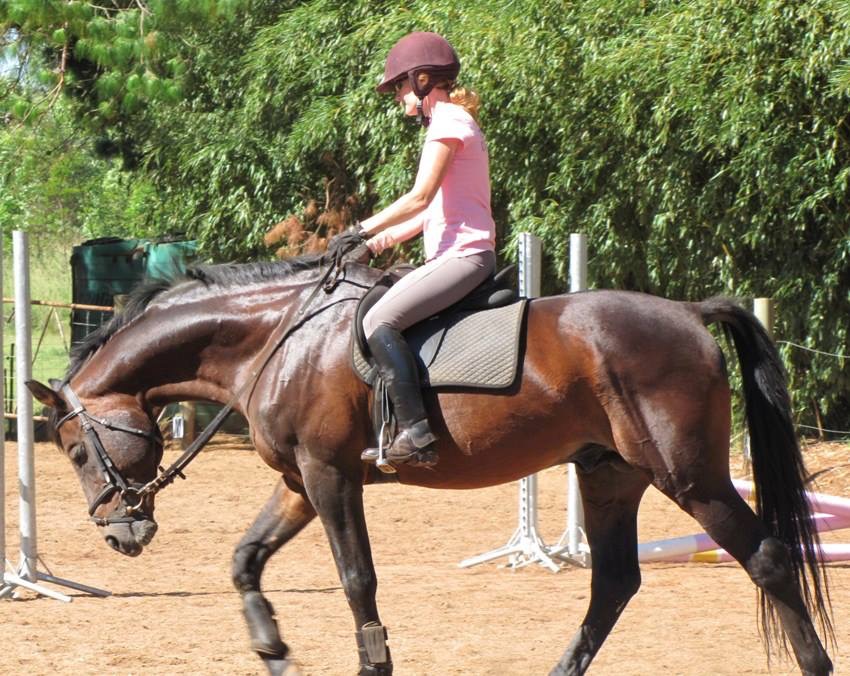
Additional Resources
Expanding your knowledge and skills in horseback riding involves ongoing learning and exploration. Here are some resources to further support your journey:
Books:
- Centered Riding by Sally Swift
- The Rider’s Edge by Janet Sasson Edgette and Tracy Bailiff
- Pressure Proof Your Riding by Daniel Stewart
- Mindful Riding by Andrea Monsarrat Waldo
- Ride Right with Daniel Stewart by Daniel Stewart
Websites:
- United States Equestrian Federation (USEF)
- British Horse Society (BHS)
- FEI – Fédération Equestre Internationale
- Chronicle of the Horse
- Horse & Hound
Online Courses and Workshops:
- Local equestrian centers and clubs often offer workshops and clinics on various aspects of riding and horsemanship.
- Check out platforms like Udemy, Coursera, or specialized equestrian training websites for online courses.
Social Media and Forums:
- Join equestrian communities on platforms like Facebook groups, Instagram, and specialized forums to connect with fellow riders, share experiences, and learn from others.
Professional Trainers and Coaches:
- Seek guidance from qualified trainers and coaches in your local area. They can provide personalized instruction and feedback tailored to your specific needs and goals.
Local Riding Clubs and Associations:
- Get involved with local riding clubs or associations. They often host events, competitions, and educational opportunities for riders of all levels.
Podcasts:
- Look for podcasts dedicated to horseback riding, horsemanship, and mental training in sports.
Continued Learning and Development:
- Attend clinics, workshops, and seminars hosted by experts in the field of equestrian sports.
- Stay up-to-date with the latest research and developments in horse training, rider biomechanics, and sports psychology.
These resources can provide valuable information, inspiration, and community support as you continue to refine your skills and deepen your passion for horseback riding.
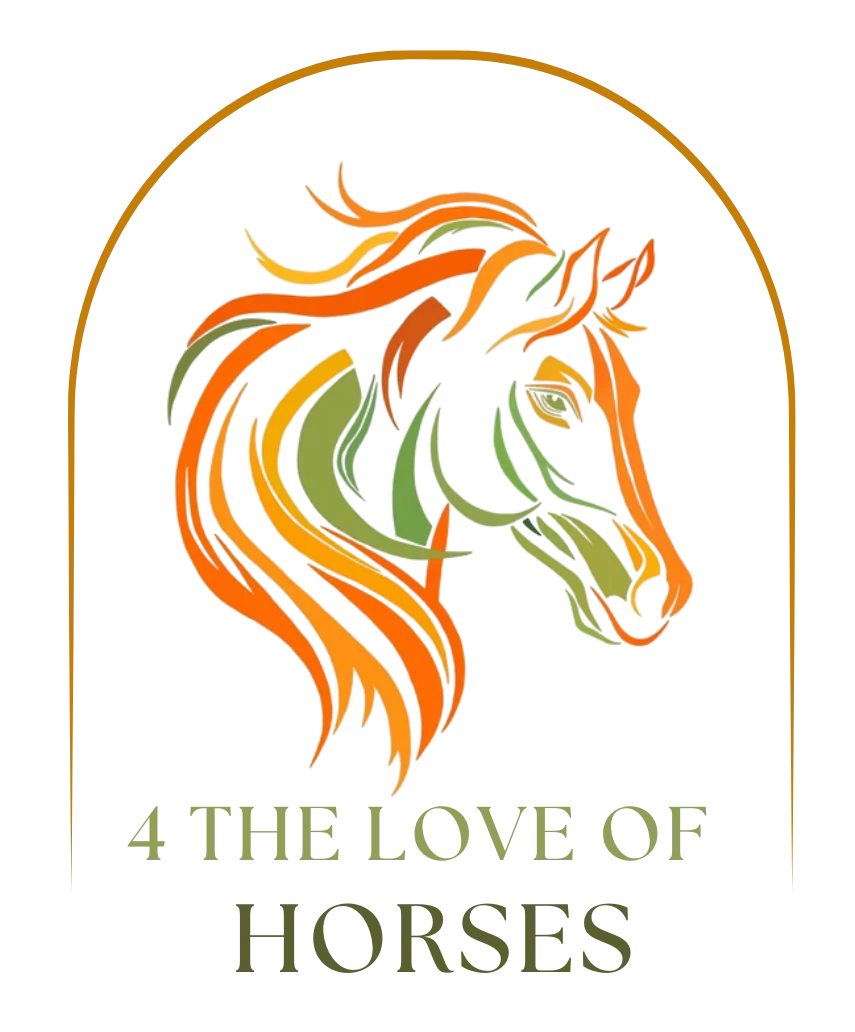

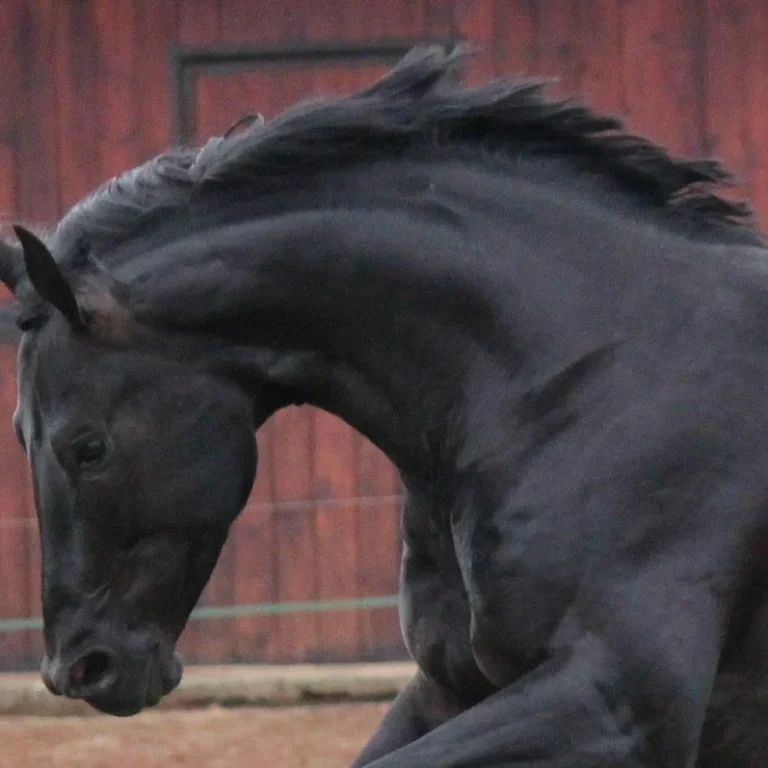
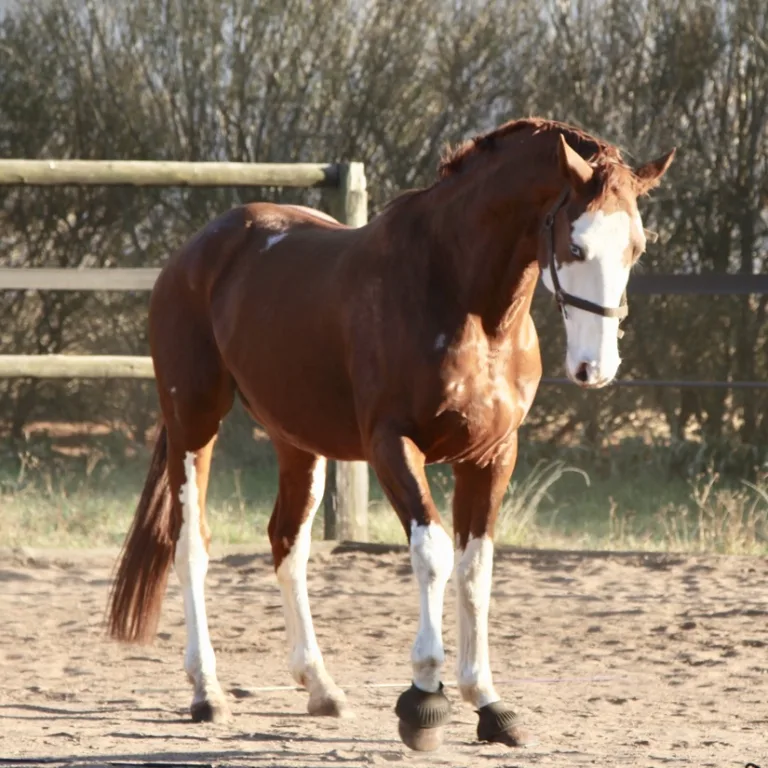
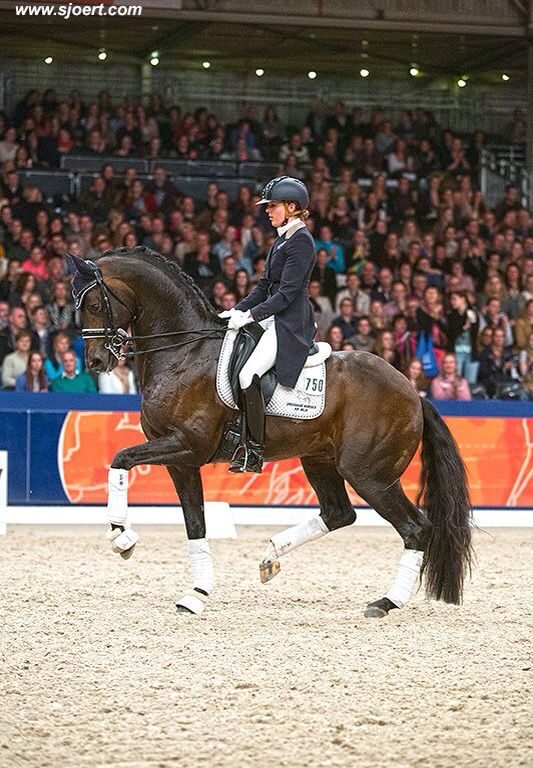
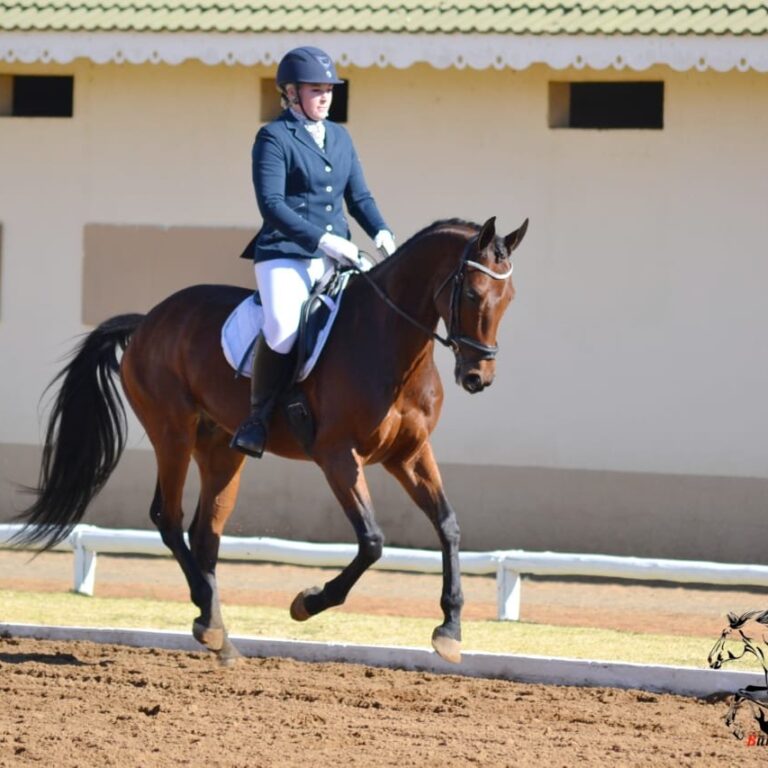
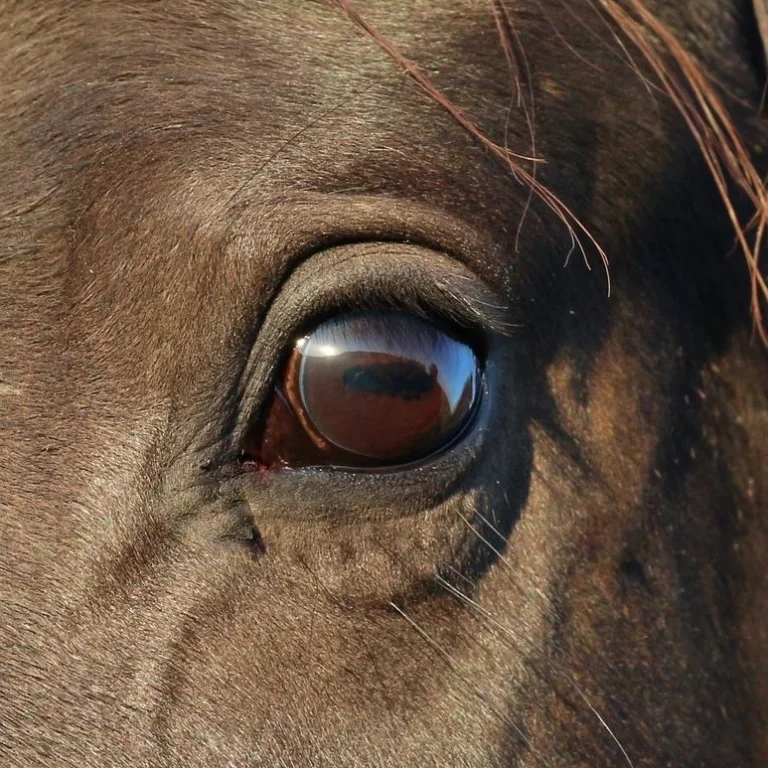
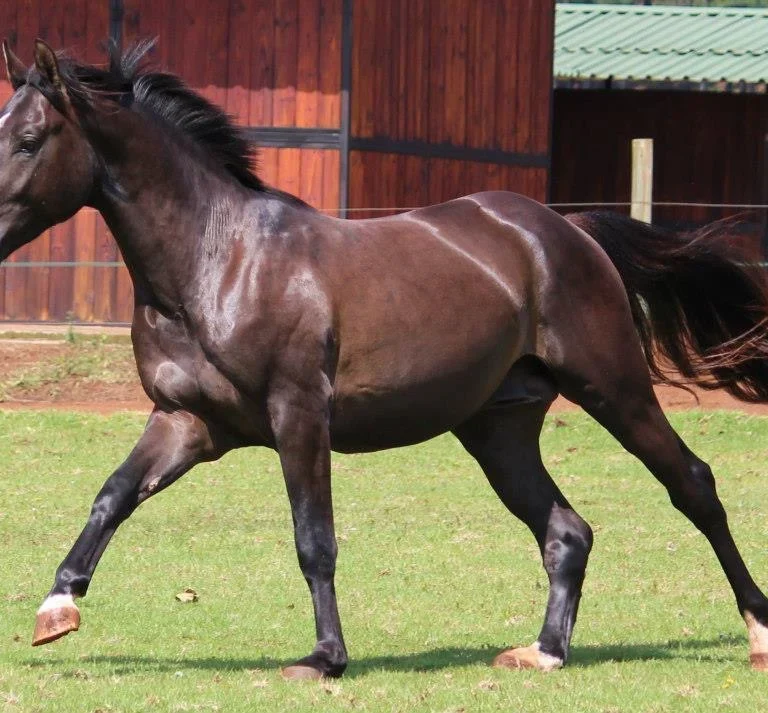
Leave a Reply